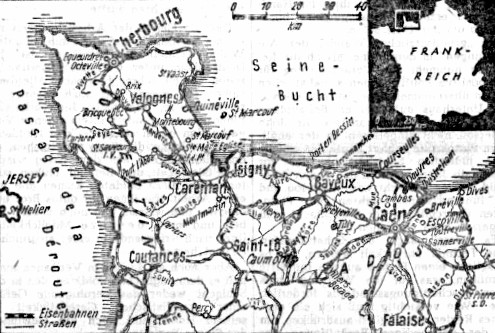Kritischer Bericht der anderen Seite –
Rückblick auf die ersten Invasionstage

Genf, 23. Juni –
In Gestalt einer rückschauenden Betrachtung auf die ersten zwei Wochen alliierter Invasionskämpfe erscheint im Daily Telegraph aus der Feder des Sonderkorrespondenten Christopher Buckley die erste nüchterne und zugleich für die anglo-amerikanische Kriegführung ungewöhnlich kritische Situationsschilderung.
Buckley schreibt, den Invasionsstreitkräften ständen zurzeit 15 wohlausgerüstete Divisionen einschließlich fünf Panzerdivisionen gegenüber, und viele weitere würden in Kürze noch zu ihnen stoßen. Die Deutschen befänden sich deshalb in keiner schlechten Lage, den lange erwarteten Gegenstoß zu führen. Aber alle deutschen Angriffe, so heftig sie auch manchmal gewesen seien, trügen einen rein örtlichen Charakter.
Buckley schildert dann die unübersichtlichen normannischen Bodenverhältnisse, die keinen weiten Durchblick zuließen. Man brauche kein Stratege zu sein, fährt er fort, um einzusehen, daß diese Landschaft eine Offensive nicht begünstige. Eine Kompanie, eine Abteilung, ein einziges Pakgeschütz oder ein einzelner Tank Seien in der Lage, den Angriff eines ganzen Bataillons zurückzuschlagen.
Jetzt, da die feindliche Front sich genügend gefestigt habe, könnten die Alliierten nicht mehr länger irgendwelche Risiken mit ihren leichten oder schweren Panzern eingehen. Die Erfolge der deutschen Scharfschützen hätten die alliierten Truppen häufig genug aus nur zu unangenehmer Nähe zu spüren bekommen. Die Deutschen zeigten in dieser Art der Kriegführung Mut und Stärke, doch sei es eine Art der Kriegführung, in der die Alliierten bisher noch keinerlei Erfahrungen sammeln konnten. Offen gestanden zeigen sich unsere Männer nicht immer als die Besten, wenn sie es mit feindlichen Scharfschützen zu tun haben. Das gleiche gelte für die Infiltrationstaktik der Deutschen.
Neben all dem spiele das Wetter eine entscheidende Rolle. Es sei in deprimierender Weise das gleiche geblieben seit dem ersten Invasionstage: immer grauer Himmel, scharfer Wind und stürmische See. Daher seien die Ausladungen am Strand über alle Erwartungen hinaus aufgehalten worden. Aber weiterhin sei es Luftmarschall Tedder nicht ein einziges Mal möglich gewesen, mit den vollen ihm zur Verfügung stehenden Verbänden im unmittelbaren Kampfraum einzugreifen. Es ist unumstößlich wahr, daß es unseren Truppen an genügender Ausbildung in den Kampfmethoden fehlt, die für die Deutschen heute selbstverständlich sind. Afrika und Italien lieferten uns keine Erfahrungen und deshalb empfinden wir jetzt in der Normandie, daß es für uns schwer wird.
In Geschützen und Panzerung, urteilt Buckley, könnten sich die deutschen Tanks durchaus gegen die Alliierten in der Verteidigung halten. Nur ein Durchbruch könnte die Alliierten in eine für ihre Tankwaffe günstigere Lage bringen, Solange das aber nicht der Fall sei, behalte ein gefangengenommener deutscher Tankoffizier recht, der sagte:
Es wird allmählich Zeit, daß ihr Wüstenmäuse erkennt, daß ihr nicht mehr länger mit euren Tanks in der Wüste operiert.
